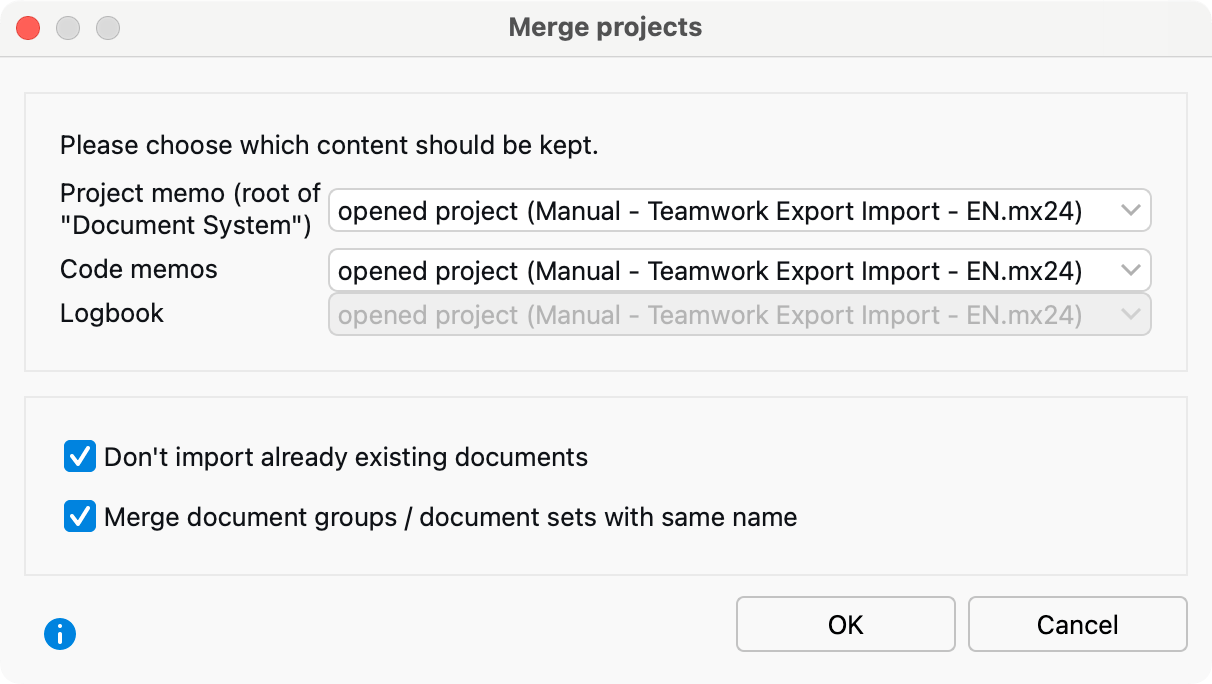The “Merge projects” function causes all elements of a second project to be added to a project you currently have open.
This is useful, for example, when several people import different data into their MAXQDA project files or transcribe different interviews and then the projects are to be merged into one that contains all documents from all projects. The function can also be used if one project contains document-independent elements such as free memos, concept maps, QTT worksheets, and Summary Tables that are to be copied into another project.
Merge projects:
1. Open one of the two projects you want to merge.
2. In the Home tab, choose Merge Projects.
3. Select the second project from the file dialog window, which will be in the form of an MQDA file.
The following dialog window will appear:

Because a MAXQDA project can contain only one project memo, one memo per code, and one Logbook, you can choose, in the top section, what content should be kept and what should be overwritten. When the default settings are left as is, the existing data in the already opened project will remain unchanged.
In the bottom section, two options are available that allow you to determine how MAXQDA should handle documents whose identical name already exists in the project:
- Don’t import already existing documents – When this option is deselected, all documents from the imported project are inserted into the open project, regardless of whether they already exist in the project. When you select this option, already existing documents will be ignored, thus not imported.
- Merge document groups / document sets with same name – Choosing this option, no further document groups and sets with the same name will be created, and the imported documents will be integrated into already existing document groups and sets.
When you click OK, MAXQDA then starts the merging process, which may take some time, depending on the size of the two projects.
What happens during merge process?
- Document groups of the imported project will be added with their documents, possibly generating duplicates. If a document group entitled “Interviews” exists in both projects, the resulting merged project will have two groups of this name. The options above can be set so that already existing documents are ignored and so that no duplicate document groups and sets are created.
- Document sets are added. If the above mentioned option is selected, sets with the same name will be merged and only sets whose name does not yet exist will be added.
- Memos will be inserted. A code memo from the import project is ignored if a memo already exists for the code – unless you select in the options dialog that the imported code memo should overwrite the existing one. The same applies to the project memo attached to the root of the “Document System”.
- Code assignments will be added.
- If a code or subcode of the imported project does not exist, it will be created. Codes with the same name and same hierarchy position will be considered identical; their color and their order on the same hierarchy level is not relevant.
- Code sets will be added, no matter if a set with the same name exists.
- Summaries will be added.
- Summary Tables will be added. If a Summary Table with the same name exists, the imported table will be ignored.
- Internal and external links within documents will be imported, as long as their start and target is located within one of the imported documents. Internal links within memos are ignored.
- Maps in MAXMaps will be added. If a map with the same name exists, the imported map will be ignored.
- Worksheets from Questions, Themes & Theories are added. If a QTT worksheet with the same name exists, its name is appended with a sequential number.
- Each variable will be analyzed to determine if it already exists in the project.
- If the variable does not exist, a variable of that name will be created. The variable values of the documents in the open project will be set to 0 or to the preset missing value for numerical variables, or set to empty for text variables.
- If a variable exists with another type declaration, it will be created. Suppose the open file contains the text variable “marital status” and the file to be added contains a numerical variable with the same name. After the merge process, two variables entitled “marital status” will exist.
